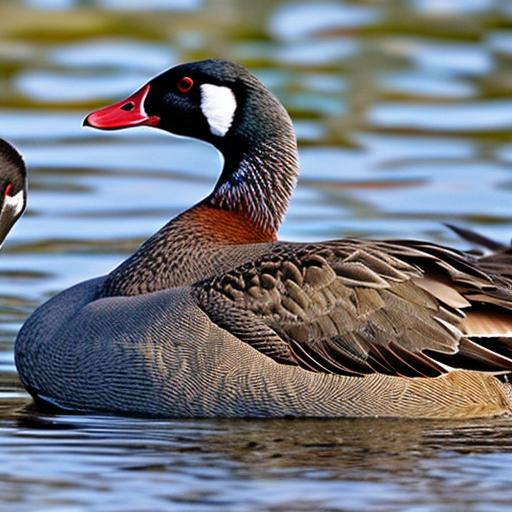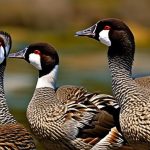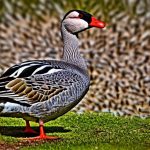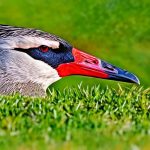Canadian geese are a common sight in many parts of North America, including Canada and the United States. While these birds can be beautiful to observe, they can also cause significant problems when they congregate in large numbers. Their droppings can create unsightly and unsanitary conditions, and their aggressive behavior can pose a threat to humans and other animals. As a result, effective management strategies are necessary to control the population of Canadian geese and mitigate the problems they cause.
Key Takeaways
- Canadian geese are attracted to areas with water and open spaces for grazing.
- Natural deterrents such as planting tall grasses and using dogs can help keep geese away.
- Physical barriers like fences and netting can prevent geese from accessing certain areas.
- Sound and visual repellents like decoys and lasers can be effective in deterring geese.
- Maintaining a clean environment by removing food sources and regularly cleaning up can discourage geese from staying in an area.
Understanding the Behavior of Canadian Geese
To effectively manage Canadian geese, it is important to understand their behavior and what attracts them to certain areas. Canadian geese are social animals that prefer open areas near water, such as lakes, ponds, and golf courses. They are attracted to these areas because they provide ample food sources, nesting sites, and protection from predators.
By understanding these preferences, property owners can take steps to make their properties less attractive to Canadian geese. For example, landscaping and vegetation management can be used to create an environment that is less appealing to geese. Planting tall grasses or shrubs near bodies of water can make it more difficult for geese to access the water and find suitable nesting sites.
Natural Deterrents for Canadian Geese
Using natural deterrents is another effective strategy for managing Canadian geese. These methods involve creating an environment that is less appealing or accessible to geese without causing harm to the birds or the environment. For example, planting certain types of grasses or plants that geese find unpalatable can discourage them from staying in an area.
Additionally, using natural predators such as dogs or trained falcons can help deter geese from congregating in certain areas. These predators create a sense of danger for the geese, causing them to seek safer locations. This method is not only effective but also environmentally friendly.
Creating Physical Barriers to Keep Geese Away
Physical barriers can be an effective way to keep geese away from certain areas. Fencing and netting are commonly used to create barriers that prevent geese from accessing specific locations. Fences should be at least three feet high and have small mesh openings to prevent geese from squeezing through.
Netting can be used to cover bodies of water or other areas where geese tend to congregate. The netting should be securely fastened to prevent geese from getting underneath it. It is important to regularly inspect and maintain these barriers to ensure their effectiveness.
Implementing Sound and Visual Repellents
Sound and visual repellents can also be effective in deterring Canadian geese. Decoys, such as plastic owls or coyotes, can create the illusion of predators in the area, causing geese to avoid the location. These decoys should be moved regularly to prevent geese from becoming accustomed to their presence.
Noisemakers, such as propane cannons or motion-activated devices that emit loud noises, can also be effective in scaring away geese. These devices should be used sparingly and strategically to avoid causing unnecessary stress to the birds or disturbing nearby residents.
Maintaining a Clean and Tidy Environment

One of the most important steps in managing Canadian geese is maintaining a clean and tidy environment. Geese are attracted to areas with abundant food sources, so it is important to remove any spilled food or garbage that may attract them. Regularly cleaning up droppings and keeping grass mowed can also discourage geese from staying in an area.
It is also important to educate others about the importance of maintaining a clean environment. Encouraging neighbors and community members to properly dispose of food waste and avoid feeding geese can help reduce the attractiveness of an area to these birds.
Utilizing Scare Tactics to Deter Canadian Geese
Scare tactics can be an effective way to deter Canadian geese from congregating in certain areas. Trained dogs can be used to chase geese away, creating a sense of danger and causing them to seek safer locations. Laser devices can also be used to create a moving light that scares geese away.
It is important to note that scare tactics should be used sparingly and strategically to avoid causing unnecessary stress to the birds. Additionally, it is important to regularly change the tactics used to prevent geese from becoming accustomed to them.
Installing Motion-Activated Devices for Geese Control
Motion-activated devices can be an effective tool for managing Canadian geese. Sprinklers or lights that are triggered by motion can startle geese and discourage them from staying in an area. These devices should be strategically placed in areas where geese tend to congregate, such as near bodies of water or on lawns.
One of the benefits of using motion-activated devices is that they are low-maintenance and can be easily adjusted to meet the specific needs of a property. They can also be programmed to operate during specific times of the day or night when geese are most active.
Seeking Professional Help for Geese Management
In severe cases where geese populations are difficult to control, it may be necessary to seek professional help for geese management. Professional geese management companies have the expertise and resources to effectively manage large populations of geese.
When choosing a geese management company, it is important to do research and choose a reputable company with experience in managing Canadian geese. The company should have a proven track record of success and use humane methods for geese control.
Educating Others on Geese Behavior and Prevention Methods
Educating others about geese behavior and prevention methods is an important step in long-term geese control. By sharing information with neighbors and community members, property owners can create a united front in managing geese populations.
Educational materials, such as brochures or flyers, can be distributed to provide information on geese behavior and prevention methods. Additionally, community meetings or workshops can be organized to discuss the issue and brainstorm solutions.
Monitoring and Adjusting Strategies for Long-Term Geese Control
Managing Canadian geese is an ongoing process that requires monitoring and adjusting strategies for long-term success. It is important to regularly evaluate the effectiveness of the chosen strategies and make adjustments as needed.
For example, if a particular deterrent method is not effective, it may be necessary to try a different approach. Regularly monitoring geese populations and their behavior can provide valuable insights into the effectiveness of current strategies and help identify areas for improvement.
Managing Canadian geese populations requires a multi-faceted approach that combines an understanding of their behavior with the implementation of effective prevention methods. By using natural deterrents, creating physical barriers, implementing sound and visual repellents, maintaining a clean environment, utilizing scare tactics, installing motion-activated devices, seeking professional help when necessary, educating others, and regularly monitoring and adjusting strategies, property owners can effectively manage Canadian geese populations and mitigate the problems they cause. With ongoing management efforts, it is possible to create a harmonious coexistence between humans and Canadian geese.
If you’re looking for effective ways to keep Canadian geese away from your property, you might also be interested in learning how to create a secure and predator-proof chicken coop. Poultry Wizard offers a helpful article on designing the floor of a chicken coop, which can provide insights into keeping unwanted visitors out. Additionally, their chicken coop run plans can offer valuable tips on creating a safe and enclosed space for your chickens. For those seeking inspiration, Poultry Wizard even has an article featuring the unique and stylish Hannah Montana chicken coop. Check out these resources to ensure the safety and well-being of your feathered friends while keeping unwanted geese at bay.
FAQs
What are Canadian geese?
Canadian geese, also known as Canada geese, are large waterfowl native to North America. They are known for their distinctive black heads and necks, white patches on their faces, and brown bodies.
Why do people want to keep Canadian geese away?
Canadian geese can become a nuisance in certain areas due to their droppings, aggressive behavior, and potential damage to property. Keeping them away can help prevent these issues.
What are some humane ways to keep Canadian geese away?
Some humane ways to keep Canadian geese away include using visual deterrents like scarecrows or reflective tape, installing fencing or barriers, using noise deterrents like air horns, and landscaping changes to make the area less attractive to geese.
Are there any laws protecting Canadian geese?
Yes, Canadian geese are protected under the Migratory Bird Treaty Act in the United States and the Migratory Birds Convention Act in Canada. It is important to check local regulations before attempting to deter or remove Canadian geese.
Can Canadian geese be relocated?
Relocating Canadian geese is not recommended as they have strong homing instincts and may return to their original location. It is best to focus on deterrent methods to keep them away.
Meet Walter, the feathered-friend fanatic of Florida! Nestled in the sunshine state, Walter struts through life with his feathered companions, clucking his way to happiness. With a coop that’s fancier than a five-star hotel, he’s the Don Juan of the chicken world. When he’s not teaching his hens to do the cha-cha, you’ll find him in a heated debate with his prized rooster, Sir Clucks-a-Lot. Walter’s poultry passion is no yolk; he’s the sunny-side-up guy you never knew you needed in your flock of friends!







